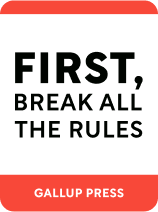

This article is an excerpt from the Shortform book guide to "First, Break All the Rules" by Gallup Press. Shortform has the world's best summaries and analyses of books you should be reading.
Like this article? Sign up for a free trial here .
What is the most important thing when it comes to personnel development? What can you, as a leader, do to help your employees level up their performance and contribution?
According to Marcus Buckingham, the author of First, Break All the Rules, personnel development is not about trying to transform your employees by weeding out their weaknesses. Rather, it is about building up their existing talents and navigating around their weak areas.
When designing your personnel development system, keep the following in mind.
Changing Perspectives on Personnel Development
Personnel development isn’t about trying to fix your employees. Rather, it’s about developing the unique talents they bring to the table. Be specific and develop a fleshed-out idea of who they are and how they work. To develop a stronger workplace, you have to reject the concept of “transformation,” build up talents and navigate around weaknesses.
The Falsehood of “Transformation”
In Hollywood, you see the trope of transformation all the time: the hero discovers their weakness and fixes it for the better. While this story is sentimental and engaging, it creates a false narrative. It says that you can make yourself whatever you want to be by fixing your weaknesses and creating new talents to take their place. This concept of “transformation” is problematic for the following reasons:
Problem #1: If everyone has unlimited potential, then nothing makes you unique.
If everyone could truly be anything they wanted to be, then no one would have a distinct identity. While you could define yourself through goals or achievements, you wouldn’t possess any unique features that made you stand out. This is because people would always fix socially unacceptable weaknesses and develop new, lucrative talents. For example, if everyone in the world could develop the talent to sing, would singers be unique or special anymore?
Problem #2: If weaknesses could be changed with persistence, why do people seem to try for years with no results?
When people try their entire lives to fix their weaknesses, they often feel like they’re putting in significant effort only to see little to no change. This futile effort develops frustration and disappointment. While persistence can help you develop skills and knowledge, it won’t give you the talents you don’t have or fix the weaknesses you already possess.
For example, Bo lacks the talent of picking up on social cues. Though he’s tried for years, his brain still doesn’t process his interactions in a way that allows him to note many of the subtle messages that body language sends. Through books and classes, he’s learned to see the physical indicators, but he still can’t accurately decipher what they mean. Because he’s poured years of his life into making a change, he’s become immensely frustrated with his inability to “transform.”
Problem #3: If you only focus on fixing weaknesses, you never talk about strengths.
If you’re always pointing out the weaknesses of your team members, emotions such as frustration or guilt will rise to the surface. While employees may have many strengths, all they’ll be able to think about are the areas that you constantly tell them they need to improve. This will lead them away from using their strengths and force them to put their energy into something they can’t change.
For example, you manage a bookstore. One of your employees, Helen, tends to avoid interacting with customers but excels at quickly restocking shelves and organizing the store. She currently works on the floor, but you decide you want to try to “fix” her weakness by putting her behind the counter. She’s uncomfortable and ineffective. Two weeks later, she puts in her notice. She loved her job when she was able to use her strengths, but, because she’s in her head about her weaknesses and doesn’t get to use her talents, she’s decided to move on.
Problem #4: If you have the ability to fix your weaknesses, but haven’t, is it your fault?
Thinking you can fix your weaknesses with hard work and willpower sends a stark message: it’s your fault if you haven’t changed. The concept of “transformation” claims that people who haven’t changed simply haven’t tried hard enough or gave up too soon. When you, as a manager, send this message to your team, you’re telling them that they’re to blame for their weaknesses when the reality is they can’t do much to change the way they are. This demoralizes employees and leads to resentment.
Build Up Talents
You only have so much time and energy. Great managers believe that it’s better for employees to put their time and energy into building their talents instead of trying to change the unchangeable. Great managers use the following rules to help employees develop their abilities:
Rule #1: Put People in the Proper Roles
When placing people into roles, know the talents associated with each role as well as the talents of each individual employee. This takes a little patience. Watch your employees over time to see how they work and how they interact with other team members. If you like being more direct, ask them about their strengths, weaknesses, and goals.
Note: this doesn’t refer simply to hiring. You can use this principle even if you have no power over hiring or need to shuffle an employee to a different position.
For example, you’ve just been promoted. You’re now the manager of a team of “marketing associates.” You didn’t have the ability to select any of your employees, and none of them have a unique title to differentiate them from one another. To coordinate your team, you do the following:
- First, you figure out what talents you need in specific roles (planner, on-site coordinator, and so on).
- Next, you get to know the strengths and weaknesses of your employees.
- Finally, you begin to place people into specific roles that allow them to use their talents. For instance, if you know Marcus is a talented communicator, he could be your liaison for events. If Teresa is a talented organizer, she could be the person who develops scheduling packets.
Don’t Fall for Stereotypes
When putting people into roles, some managers inadvertently place them according to stereotypes. Stereotypes surrounding certain genders, ethnicities, and/or positions cloud your judgment when analyzing your employees. Be sure to give members of your organization individualized attention and care. Great managers can assess the difference between people. They don’t make broad assumptions about the differences between groups of people.
Rule #2: Break the Golden Rule
The “Golden Rule”—treating everyone the same—isn’t efficient. You need to relate to your employees based upon their individual needs.
For example, if Tommy enjoys public recognition for his work but Henry prefers private recognition, they’re not going to feel the same satisfaction at having a lunch party in the break room thrown in their honor. Where Tommy would probably love it, Henry probably wouldn’t. Instead, praise Henry with a note and a meaningful gift.
Rule #3: Spend More Time With Your Best
Traditionally, managers feel the need to spend more time with employees who are struggling because they think that’s the best approach to increase overall productivity. They tend to spend time trying to instruct or control these employees to increase performance.
Great managers focus on turning talent into performance, not controlling or instructing their team members. They create ways to help employees unleash their potential through their individual talents by doing the following:
- Creating unique expectations. Each employee is motivated by different things. Great managers take the time to create individualized goals for each employee to strive for.
- Focusing on unique styles. Great managers make sure employees can use their unique talents and respect the ways that they approach the work.
- Protecting team members. Great managers know when to run interference between team members and leadership. They know how to play the administrative game to make sure their employees are in a position to succeed.
The more talents an employee uses, the more potential they possess. With this in mind, great managers can’t help but be drawn in by their most talented employees as it’s a more efficient use of their efforts. As you begin to put more energy into your best employees, keep the following tips in mind:
Tip #1: “No news” isn’t good news
The phrase “no news is good news” is often used by managers to express that, if an employee hasn’t heard anything from them, that’s good news. This is because these managers tend to only speak with their employees if there’s an issue. However, this belief can be dangerous.
Part of a manager’s job is to promote productive behaviors and remove ineffective ones. Your voice has more power than you think. If you fail to praise productive employees, their productive behaviors will begin to fall away. This is because people require some level of validation. When you ignore the good work of your strongest employees, you’re effectively telling them that you don’t care about their efforts. This may lead to your star employees acting out or giving up.
When focusing on your best, don’t make promises about the future. Focus on what they’re contributing today. Your words have more power than you realize because your best performers often don’t know that their work is as valuable as it is.
Tip #2: Focus on your best because it’s the fair thing to do
While you should try to be fair, fairness isn’t giving everyone the same amount of attention. It’s giving attention proportionate to the amount of work a person puts in and the amount of success that they have. While this sounds blunt, it doesn’t make sense for you to invest your time into someone who doesn’t work hard or will never yield productive results.
For example, two of your employees, Tabitha and Rolando, are working on separate projects. Tabitha tends to avoid work and doesn’t produce solid results. On the other hand, Rolando always works hard and creates strong results. Though you may be tempted to focus on getting Tabitha up to standard, Rolando deserves more of your attention. His hard work and tendency to perform mean that your efforts will yield better results with him than with Tabitha.
Tip #3: Study your best
When you spend time with employees who struggle, you gain a clear picture of what failure looks like. However, this doesn’t help you see what excellence looks like. Contrary to popular belief, excellence isn’t the absence of failure. It requires a different structure that can only be discovered by studying what works instead of what doesn’t.
Spend time with your best employees. Watch them work. You can learn how to help others handle challenging obstacles by observing how your successful employees handle them. Ask them questions. They will often have insight that can guide you in developing strategies. Also, it helps you better understand your successful employees’ talents. This allows you to find the best ways to support them in their work and gives you a guide when hiring new employees for similar roles.
Tip #4: Make your good employees into great employees
Many managers obsess over average figures. Average figures show you the typical output of your organization and develop a level of “acceptable” performance. While it’s important to know the average efficiency of your office, it’s ineffective to use these figures as a barometer for success. You want your employees to be excellent, not average.
Don’t spend time on employees who are below average or average. Instead, spend time on good employees who have potential, but know that it’s hard work to make even good employees truly great.
Tip #5: When possible, avoid setting quotas and focus on praising excellence
When you focus on getting your team to reach a quota, your employees will coast once they’ve hit their goal. For example, a sales team that hits a quota of 100 sales per quarter will coast once they hit it. Instead, praise your top salespeople, use them as an example of excellence, then use their striving talents to continue to push them to excel.
Unfortunately, you often won’t have power over this as leadership or higher management may require you to set these goals for your team. When this happens, devise a plan that focuses on their striving talents and pushes them to excel beyond an “average” quota.
Navigate Around Weaknesses
Focusing on talent doesn’t mean ignoring weakness or failure. Mistakes and poor performance need to be addressed quickly, but you need to address them properly to avoid frustrating employees or wasting your energy.
Preliminary Questions
First, ask yourself four questions:
- Is the poor performance due to personal issues? If this is the case, offer your employees empathy and patience. Though they will eventually have to get back to focusing on their work, employees need some time to properly work through personal issues. These may include a death in the family, the hospitalization of a friend, a child getting into serious trouble, and so on.
- Is the poor performance due to a lack of proper tools or knowledge? If this is the case, give your employees the resources and information they need to excel. Tools can include anything from a more durable saw for a carpenter to a faster computer for an accountant. Information can include anything from an updated handbook for a new employee to an informational meeting between departments.
- Is the poor performance due to a lack of skills? If this is the case, give your employee the training they need to succeed. For example, you hire a client relations associate and give them the job of creating PowerPoint presentations. You notice they have slow turnaround times on these presentations despite having the proper talents to excel. When you approach them about this, they admit that they never received formal training on PowerPoint. With this in mind, you get them into a PowerPoint online course, and, within a few weeks, they’re efficiently creating client presentations.
- Is the poor performance due to mishandled motivations? You need to discover what motivates each of your employees. Without this knowledge, you may be trying to push your employees in a way that frustrates or annoys them. For example, you run a software development team. You decide to host a competition for your coders that includes a bonus for the employee who develops the most lines of code in the current quarter. However, your particular team is mostly made up of people who are motivated by completion, not competition. Throughout the quarter, you actually see a drop in both productivity and morale as your team starts to grow frustrated at having to be in competition with one another.
If you answered “yes” to one of the questions above, you have direct control over the factors needed to make a change. This is because these questions relate to temporary (personal issues) or changeable (knowledge, skills, and motivations) factors.
However, if you answered “no” to all of the questions above, you don’t have direct control over the factors needed to make a change. This is because your issue is likely related to talent.
Making Adjustments
It’s not uncommon to encounter an issue related to talent. No one has every talent related to their particular role. However, in a situation where an employee’s weaknesses are severely impacting their ability to do their job, you need to make some adjustments.
Step One: Differentiate Between Non-Talents and Weaknesses
A non-talent is a talent you don’t have, but don’t have to use. On their own, non-talents are harmless. For example, if you’re terrible at remembering names, but your position never requires you to meet new people, your non-talent doesn’t impact your ability to work.
However, non-talents become weaknesses as soon as they become necessary to a role or position. For example, if you’re terrible at remembering names, and your new position frequently requires you to meet new people, your non-talent suddenly becomes a weakness. Knowing the difference between the two allows you to watch for the moments when your employees’ non-talents turn into weaknesses and impact performance.
Step Two: Use Methods to Help Struggling Employees
There are three methods you can use to help someone succeed despite their weaknesses:
Method #1: Create a system of support. In regards to talent, support systems are tools and methods that help employees turn their weaknesses into non-talents. For example, if someone is bad at remembering when meetings are, have them put a calendar app on their computer that pings and shows a notification 15 minutes before their scheduled meetings. This changes their inability to remember scheduled meetings from a weakness to a non-talent.
Method #2: Pair people together based on their talents and weaknesses. This will create a mutually beneficial relationship in which each employee can use their talents to cover the other person’s weaknesses. For instance, say you manage a team of sales reps. Rebecca always remembers names but struggles with her elevator pitch while Frank is terrible at remembering names but delivers a fantastic elevator pitch. With this in mind, you put Rebecca in charge of initiating conversations with potential clients and Frank in charge of then pitching the product.
Method #3: Promote individual roles within teams. If you require someone to constantly rotate into a role or task that they’re not talented in, they won’t excel. Rather than requiring your employees to play all of the team’s roles, focus on the strengths and weaknesses of each employee and define their responsibilities accordingly. This allows each team member to use their talents while someone else covers their weaknesses. Once everyone is in a proper position and talents are balanced, you can build a level of proficiency throughout your team that allows them to cover different roles in the event of an emergency or unexpected development.
For example, you manage a retail store with the following employees:
| Employee | Talent | Weakness |
| Ricky | Communication | Problem-Solving |
| Yolanda | Organization | Communication |
| Shen | Problem-Solving | Organization |
You assign Ricky to walk the floor and talk to customers about their needs. You put Yolanda in charge of organizing displays and maintaining dressing rooms. Finally, you put Shen in charge of the register and customer service. This makeup allows each individual to perform tasks that promote their individual strengths and navigate around their weaknesses. Once everyone knows their primary responsibilities, you teach them the requirements of the other positions. While they won’t rotate into these roles frequently, it gives them the ability to cover these positions in case of a sudden rush or emergency.
Step Three: Move or Remove Poor Performers
At the end of the day, if an employee is still performing poorly because of their weaknesses, they can’t stay in their position. Either find them an alternative role that better suits their talents or say goodbye.

———End of Preview———
Like what you just read? Read the rest of the world's best book summary and analysis of Gallup Press's "First, Break All the Rules" at Shortform .
Here's what you'll find in our full First, Break All the Rules summary :
- Why only 13% of the world’s workforce is actively engaged at work
- How to find strong employees and keep them
- The 12 questions to ask your employees that help you determine the strength of your organization






